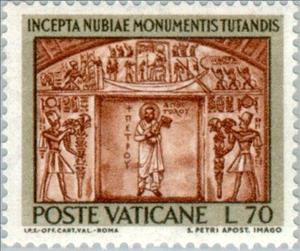Stamp: Protection Nubical Monuments (Vatican City 1964)
Protection Nubical Monuments (Vatican City 1964)
01 January (Vatican City ) within release Protection Nubical Monuments goes into circulation Stamp Protection Nubical Monuments face value 70 Vatican lira
| Stamp Protection Nubical Monuments in catalogues | |
|---|---|
| Michel: | Mi:VA 448 |
| Yvert et Tellier: | Yt:VA 399 |
Stamp is square format.
Also in the issue Protection Nubical Monuments:
- Stamp - Protection Nubical Monuments face value 10;
- Stamp - Protection Nubical Monuments face value 20;
- Stamp - Protection Nubical Monuments face value 70;
- Stamp - Protection Nubical Monuments face value 200;
|
Data entry completed
46%
|
|
|---|---|
| Stamp Protection Nubical Monuments in digits | |
| Country: | Vatican City |
| Date: | 1964-01-01 |
| Perforation: | 14 |
| Format: | Stamp |
| Face Value: | 70 Vatican lira |
Stamp Protection Nubical Monuments it reflects the thematic directions:
A monument is a type of structure that was explicitly created to commemorate a person or event, or which has become relevant to a social group as a part of their remembrance of historic times or cultural heritage, due to its artistic, historical, political, technical or architectural importance. Examples of monuments include statues, (war) memorials, historical buildings, archaeological sites, and cultural assets. If there is a public interest in its preservation, a monument can for example be listed as a UNESCO World Heritage Site. The Palgrave Encyclopedia of Cultural Heritage and Conflict gives the next definition of monument:
Painting is the practice of applying paint, pigment, color or other medium to a solid surface (support base). The medium is commonly applied to the base with a brush, but other implements, such as knives, sponges, and airbrushes, can be used. Painting is a mode of creative expression, and the forms are numerous. Drawing, gesture (as in gestural painting), composition, narration (as in narrative art), or abstraction (as in abstract art), among other aesthetic modes, may serve to manifest the expressive and conceptual intention of the practitioner. Paintings can be naturalistic and representational (as in a still life or landscape painting), photographic, abstract, narrative, symbolistic (as in Symbolist art), emotive (as in Expressionism), or political in nature (as in Artivism). A portion of the history of painting in both Eastern and Western art is dominated by spiritual motifs and ideas. Examples of this kind of painting range from artwork depicting mythological figures on pottery, to Biblical scenes rendered on the interior walls and ceiling of the Sistine Chapel, to scenes from the life of Buddha or other images of Eastern religious origin. In art, the term painting describes both the act and the result of the action. The support for paintings includes such surfaces as walls, paper, canvas, wood, glass, lacquer, clay, leaf, copper and concrete, and the painting may incorporate multiple other materials including sand, clay, paper, plaster, gold leaf, as well as objects. The term painting is also used outside of art as a common trade among craftsmen and builders.
n Christian belief, a saint is a person who is recognized as having an exceptional degree of holiness, likeness, or closeness to God. However, the use of the term saint depends on the context and denomination. In Catholic, Eastern Orthodox, Anglican, Oriental Orthodox, and Lutheran doctrine, all of their faithful deceased in Heaven are considered to be saints, but a selected few are considered worthy of greater honor or emulation. Official ecclesiastical recognition, and veneration, is conferred on some denominational saints through the process of canonization in the Catholic Church or glorification in the Eastern Orthodox Church after their approval.In many Protestant denominations saint refers broadly to any holy Christian, without special recognition or selection.



